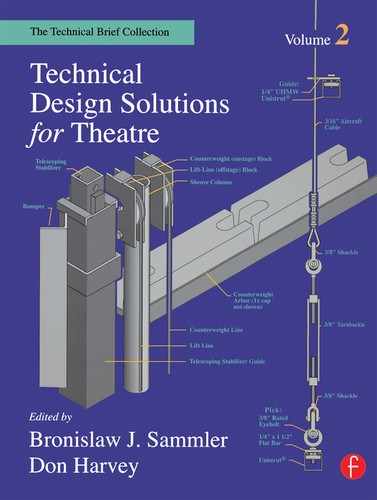Building Distorting Mirrors |
Colin Young |
Sometimes we’re so attracted to one of a material’s uses that we’re blinded to its other possibilities. We commonly use sheet Plexiglas® as a safe substitute for panes of glass because it’s transparent and shatter-resistant. Most of the time, we want it to remain rigid, planar, and transparent — just like glass. Perhaps that’s why, when the Yale Summer Cabaret needed a distorting fun-house mirror, it took us so long to realize that mirrored Plexiglas® is exactly the right material.
Mirrored Plexiglas® comes in 4×8 sheets costing about $200, but smaller low-cost/no-cost scraps can be found at large-volume glass or plastic shops that have no use for small pieces. Experimenting with some cost-free scraps of mirrored Plexiglas® that we found in a glass store, we were surprised to find that we were able to build an entirely convincing mirror simply by bending ⅛″ mirrored Plexiglas® over an irregular surface and fastening it down securely. Eighth-inch mirrored Plexiglas® is much more flexible than we had anticipated: we found that we could easily bend a 2′-wide strip into a 9″-diameter cylinder. And it’s easy to cut as long as you use an appropriate blade.
As far as this particular use was concerned, once we had cut the mirrored Plexiglas® to the right size and shape, we pushed it into place against a “terrain” we had built out of scrap lumber fastened to the back of a hollow-core door with screws and glue. We experimented with three different mounting techniques: pin-mounting by means of screw-in mirror mounts that clamped down over the edge of the mirrored Plexiglas®; pin-mounting by means of screws through holes in the Plexiglas® itself; and continuous-edge mounting by means of hot-melt glue. Ultimately, we used a combination of screws through the mirrored Plexiglas® and a bead of the hot-melt glue. The mirror took little time to build, cost next to nothing, and distorted images just as we wanted it to.
A health-and-safety postscript …. It is possible to squeeze a slightly tighter bending radius out of Plexiglas® by heating it carefully and evenly with a heat gun. But heating Plexiglas® (and even machining it) releases noxious gases. Craftspeople are warned to work in a ventilated area and to wear appropriate respirators as well as safety glasses whenever they work with this wonderfully versatile material.
